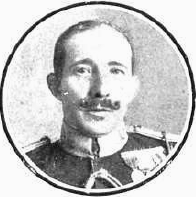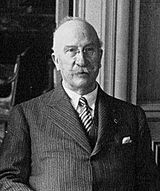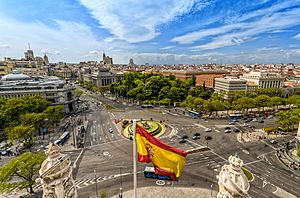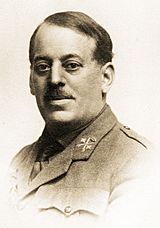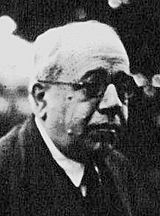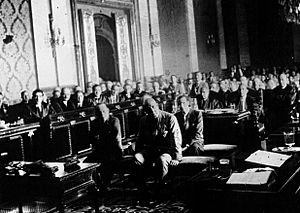Sanjurjada facts for kids
Quick facts for kids Sanjurjada |
|||||||
|---|---|---|---|---|---|---|---|
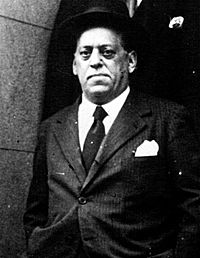 José Sanjurjo |
|||||||
|
|||||||
| Belligerents | |||||||
| Government forces | Rebel forces | ||||||
| Commanders and leaders | |||||||
| Manuel Azaña | Emilio Barrera | ||||||
| Strength | |||||||
| Most of the army | Seville garrison, some 300 people in Madrid | ||||||
| Political support | |||||||
| Most centre-republican parties and some left-wing parties | Some monarchist and centre-republican politicians | ||||||
| Casualties and losses | |||||||
| Around 10 KIA and 20 WIA (mostly rebels) | |||||||
The Sanjurjada (Spanish: [saŋxuɾˈxaða]) was a military uprising in Spain. It happened on August 10, 1932. The goal was to remove the government, but not necessarily to end the Republic.
There were short fights, and the uprising was quickly stopped in Madrid. Not much happened anywhere else, except in Seville. There, a rebel general named José Sanjurjo took control for about 24 hours. But he gave up when the government responded strongly. Because of his short success and the attention he got in court, the whole uprising was later named after him.
Contents
Why the Uprising Happened
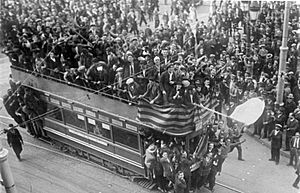
Many military officers in Spain were not very excited about the new Republic. They often preferred a king (monarchists) and were more traditional. However, after a time when the army was involved in politics, most officers wanted to stay out of it.
But then, the new government started to make big changes to the army. These changes were led by Prime Minister Manuel Azaña. He wanted to make the army smaller and ensure it was controlled by the government, not by military leaders. This made many officers unhappy. Azaña's way of speaking about the army also made them feel disrespected.
Some politicians saw that the military was unhappy. They tried to use this to their advantage. These politicians included some who wanted the king back and some who were Republicans but wanted a less extreme government.
Planning the Uprising
Since late 1931, some officers had been talking about a possible uprising. These talks were not very organized at first. The most important officers involved were Manuel Goded and José Sanjurjo. Other generals and lower-ranking officers also joined. A few politicians, like Manuel de Burgos y Mazo, were also part of the plan. It's believed that only about 5% of all officers supported the uprising.
Some important politicians, like Alejandro Lerroux, knew about the plan. But they didn't clearly support it or stop it. The leader of a new center-right party, José María Gil-Robles y Quiñones, refused to join from the start.
The government knew about the plan because the plotters were not very secretive. Prime Minister Azaña decided not to stop them early. Instead, he let the plan unfold, almost like setting a trap. He made sure loyal commanders were ready. He also moved some high-ranking officers who were part of the plot. On August 9, Azaña knew exactly what the plotters planned for the next day. He warned generals in other cities and made sure loyal police were near the Ministry of War.
The Rebel Plan
The rebels hoped a few determined officers in key military bases would act quickly. General Barrera was supposed to be the main military leader. In Madrid, the plotters expected two infantry regiments and two cavalry regiments to join them. They planned to take over the Ministry of War and then other important places in the capital.
At the same time, other plotters were supposed to take control of military bases in cities like Seville and Pamplona. If things got stuck in Madrid, these other cities would send help. The rebels didn't expect much resistance. They thought the government would give up easily. They also believed that most of the army would not get involved. They didn't expect much fighting or bloodshed.
The rebels also tried to get help from Fascist Italy. But it's not clear if they received any help.
The rebels' political goals were not very clear. Some wanted to bring back the king, while others wanted to keep the Republic but with a different government. They generally agreed to remove the current government. After a successful uprising, a military group would take power. They would then organize new elections for a new parliament.
The Uprising in Madrid
The rebels knew their plan was risky, but they feared being arrested if they waited. The uprising was set for 4 AM on August 10, 1932. In Madrid, a small group of about 100 officers and civilians tried to enter the Ministry of War. But guards fired at them, and they had to retreat. Another small group tried to take over the main post office building but were also stopped.
None of the main army units that were supposed to join the uprising in Madrid did. Only one small unit of about 70 soldiers marched out. They met other rebels, and the group grew to about 300 men. However, loyal government forces, including the Guardia Civil and Guardia de Asalto, were already in position around Plaza de Cibeles.
A shootout lasted about 30 minutes. The loyal forces surrounded the rebels, who then gave up. Prime Minister Azaña watched from the Ministry. By 8 AM, the uprising in Madrid was over.
The rebel leaders in Madrid, Barrera and others, managed to escape. Barrera tried to fly to Seville, where Sanjurjo was, but had trouble with his plane. He eventually made it to Seville, only to find out Sanjurjo had been caught. Barrera then fled to France.
The Uprising in Other Cities
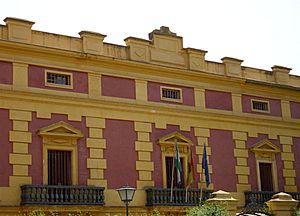
Almost no other military bases in Spain joined the uprising. One reason was that many local plotters didn't get the final order to act. Also, many were unsure and preferred to join an uprising that was already winning, rather than start one. The main reason, though, was that the government had taken steps to prevent it. Azaña had warned trusted commanders in other cities, and they took extra precautions.
The only major city where the uprising succeeded was Seville. General Sanjurjo was in charge of the rebels there. He arrived in Seville around 5 AM on August 10. He sent messages to the local governor and military commander, demanding they join him.
Sanjurjo decided to act. He appeared in a main square, and the local Guardia Civil cheered for him. Most military units in Seville then joined the uprising. Sanjurjo moved his command post to the Capitania General building. He declared a state of war, gave interviews, and issued a statement. By 10 AM, he was in full control of Seville. He knew the Madrid uprising had failed, but he wasn't sure about other cities. He also knew that rebels had taken control of Jerez de la Frontera, a nearby city.
Sanjurjo's Rule in Seville
The rebels controlled Seville for less than 24 hours. So, it's hard to know exactly how they would have ruled. However, Sanjurjo did take some actions that show his ideas.
On the morning of August 10, he issued a statement. It was long and unclear. It criticized the government for causing suffering and injustice. It also hinted that new regional laws were hurting Spain. The statement promised to bring back order and justice. It said a temporary military group would rule and then hand power to a new, elected parliament. The statement did not mention a king or religion.
Sanjurjo removed the civil governor and military commander. He talked with local conservative politicians, some of whom owned land or wanted the king back. He seemed to trust the Carlists the most. He appointed a Carlist as the new civil governor. No widespread arrests or harsh actions were taken. However, police on horseback were sent to break up a crowd of workers who were protesting against Sanjurjo.
The Uprising's Defeat
Even though the government lost control of Seville, Azaña was determined to get it back. Two infantry regiments and artillery units were gathered in Madrid. In the early afternoon of August 10, they were put on trains and sent to Seville. More troops were brought from Africa to Cadiz, and bombing planes were moved to Cartagena. Commanders in nearby cities were told to prepare for battle. That evening, the first loyal government units started to arrive south of Seville. Trade unions in Seville also declared a general strike, meaning workers stopped working.
By late afternoon, Sanjurjo knew the uprising had failed everywhere else. He also learned that government troops were heading for Seville. At first, he seemed ready to fight. Sanjurjo was known as the "Lion of the Rif" for his bravery in past wars. But as the night went on, he realized his position was very difficult. He was isolated, and the government was clearly determined to act.
Around 1 AM on August 11, two of his top officers told Sanjurjo they would not fight in what looked like a civil war. Sanjurjo then gave up and released his officers from their duties. Soon after, he got into a car with his son and an aide. They drove west, possibly trying to escape to Portugal. But they were caught near Huelva around 4:30 AM. In the early morning hours of August 11, the rebel troops in Seville surrendered. Just like when Sanjurjo took over the city, no shots were fired, and no one was hurt during the surrender.
Results and What Happened Next
Compared to other violent events in the Second Republic, this uprising did not cause much bloodshed. This was partly because the government knew about the plot and stopped it early. Also, Sanjurjo, the only rebel with many troops, backed down when he faced a civil war. About 10 people died, mostly rebels, and around 20-30 were wounded. There was no major damage to buildings.
The main plotters who were caught faced trials. Sanjurjo was sentenced to death, but this was changed to life in prison. Other leaders who escaped Spain were not allowed to return. About 200 officers were put on trial. Many were sent to a military prison in Africa. About 300 officers who were involved but not directly fighting were removed from their commands.
The government also took advantage of the uprising to crack down on groups it saw as anti-Republican. About 382 families involved in the uprising had their land taken away. Around 5,000 people were arrested for a few days or weeks. About 130 newspapers were temporarily closed, and many offices of parties thought to be involved were shut down.
Azaña also made sure that the Guardia de Asalto, a police force, was loyal to the Republic. He also reduced the power of the Minister of War. Control over other armed forces, like the border guards (Carabineros) and the Guardia Civil, was moved to different government ministries.
Long-Term Effects
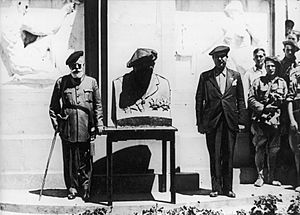
Even though the uprising failed, it had a big impact on what happened next in Spain. One important result was that the Left (more liberal groups) became even more extreme. They believed that conservative groups would never accept the Republic. This led to more aggressive speeches and armed groups. For the Right (more conservative groups), getting amnesty (forgiveness) for those involved in the Sanjurjada became a key goal in the 1933 elections. This made the political scene even more divided.
Prime Minister Azaña became too confident that the military was weak. This might have made him too relaxed when another uprising happened in 1936. The Sanjurjada also weakened the Radical Party. Future plotters learned that any uprising needed to be led by officers who held important command positions, which is what happened four years later. They also focused too much on the army and didn't think enough about how ordinary people might resist.
For Gil-Robles, the Sanjurjada showed that violence was not the answer. This made him focus on legal and constitutional ways to achieve his goals. Finally, the events made Sanjurjo a symbol for later plots. This led to him being named the leader of the 1936 uprising.
There are different ideas about how the Sanjurjada affected the Republic's stability. Some say it made the Republic stronger. Others believe it weakened the Republic by making Spanish politics even more unstable. It was the first major attempt against the Republic's government. It became a reference point for both the Right and the Left, who then planned their own secret actions. Some compare it to older Spanish military uprisings. Others see it as a preview of the Civil War itself.
See also
 In Spanish: La Sanjurjada para niños
In Spanish: La Sanjurjada para niños


